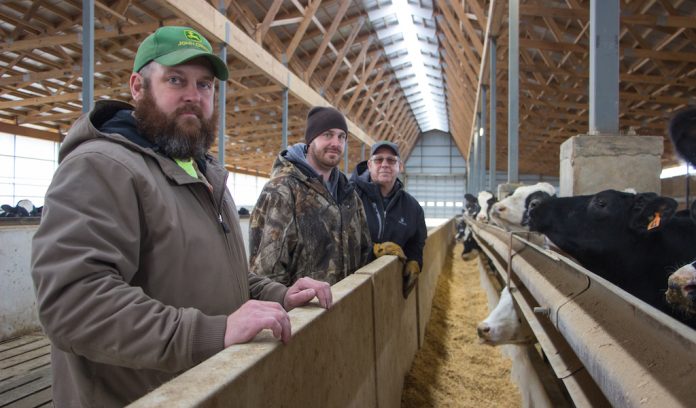
(Scroll down for video)
BELLEVUE, Ohio — When the Lepleys decided to build a new cattle facility in Huron County, they knew they would have some hurdles to jump through.
Lepley Farms — owned by Dave Lepley, who farms with his sons, Joe and Bryan — is in the easternmost part of the Western Lake Erie Basin.
The Lepleys had maxed out the capacity of their current beef facilities and were looking to expand, but knew they would be up against some strict water quality regulations when building the new facility.
“We figured we better jump the hurdle now if we’re going to spend that kind of money,” Dave Lepley said.
Every stage of the construction was carefully planned and monitored — from the nearly 4 million gallon manure pit designed to hold the manure for longer periods to a special liner to prevent manure leakage.
“We made sure we covered everything we could to comply with the Lake Erie Watershed,” said Joe Lepley.

Water quality
The Lepleys started construction on their new beef finishing barn in the spring of 2017.
“Around here, bedrock is 10 feet down,” said Joe. With plans to construct a 12-foot deep manure pit underneath the barn, they would be digging into an aquifer.
Before the concrete could be laid, a rubber liner had to be put down to prevent any liquids from getting into the water supply. A test well was also installed for the EPA to test the water near the barn twice a year.
The manure pit is designed to hold manure for 400 days, storing up to 3 1/2 million gallons of liquid, so it only has to be hauled out once a year.
“We can’t haul manure from December through April 1,” said Joe, referring to the new water quality laws implemented in the Western Lake Erie Basin.
“On the agronomy side, we can replace around a quarter of our commercial fertilizer and use liquid manure,” said Joe. “It all comes full circle.”

Comfort equals efficiency
The first cattle were moved into the new barn in the fall of 2017. The completed facility is 320 feet long by 110 feet wide and can house up to 1,000 head of cattle.
The barn is divided into eight holding pens, which contain cattle at various ages from yearling to finish. “The goal is to have a constant flow of cattle,” said Joe. “When one group goes out, we cycle in a new group.”
Efficiency is key with this new facility. Slatted floors allow manure to pass through to the pit below so cattle are not lying in excrement. There is no straw or bedded pack, but rubber mats, called Animat, line the floor to increase cattle comfort.
“They should name these barns cattle comfort facilities,” said Dave. “This environment is better on hooves and joints.”
And when you relieve stress on the animal, they perform that much better, he added.
Feeding time
The Lepleys farm a little over 2,200 acres of corn and soybeans and can supply most of their feeding needs, aside from additional supplements like distillers grain and barley.
“We’ve decreased feed costs by 20 percent in six months compared to what we initially thought we would,” said Joe.
They are looking into installing a robotic feeder two to three years down the road. His research has found the feeder can improve rate of gain by adding more feeding times per day.
The cost of the robot would be similar to purchasing a new tractor and mixer and animal efficiencies would help pay off the system in two to three years.
“We are always trying to keep up with technology, but also keep things simple,” said Joe.

Holsteins
The Holstein breed is the breed of choice for the Lepleys. “We chose the Holstein breed because of the availability of stock,” said Dave.
Large dairies in the western Ohio and Indiana area created a surplus of calves that allow the Lepleys to get animals for a more practical price.
“It’s just economics,” said Dave. “If it was better to raise colored cattle, we would.”
The cattle are contracted through United Producers, which sources yearling cattle for the Lepleys. They also set aside 25-30 cattle each year to sell as freezer beef.

One man show
“We are trying to grow animals the most efficient way possible,” said Joe. He added the design of this type of barn allows one person to manage 1,000 head.
“It’s just a different time right now,” said Joe. “With all the rulings and regulations, it’s hard if you want to have extra help.”
Currently, Dave and his sons split the work evenly on the farm. Bryan handles most of the cattle feeding and walks the barns with his father each day. Joe and Dave plant corn, Bryan plants soybeans and Joe handles the spraying.
“They started out young,” said Dave of his two sons. “I had them shelling corn when they were 12 years old.” Dave is the fifth generation to run the family farm, making Bryan and Joe the sixth generation.
The original feedlot facility was a hip roof barn with a dry pack and concrete built in 1966. The barn maxed out at 300 head. By building the new facility, they were able to increase to 1,000 head with less work.
“It’s just amazing how efficient this building is,” said Dave. “You can focus on feeding and health (of the cattle) versus hauling manure and cleaning.”











